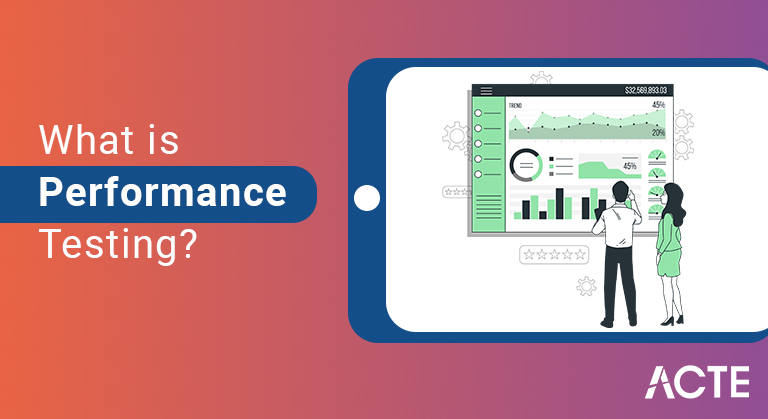
What is performance testing ?
The purpose of the evaluation is to assess how a system or application responds, behaves, and scales in response to a defined workload. The primary objective of evaluations of performance is to measure how quickly, reliably, and efficiently a system or program uses its resources.
In order to evaluate how well a system or application performs under real-world conditions, performance testing must simulate those conditions and expose it to varying degrees of stress. It aids in the detection of possible production environment bottlenecks, vulnerabilities, and performance concerns.
Some of the main points of performance testing are to ensure:
- The speed with which a program or system reacts to human input is a metric that may be measured.
- By measuring the number of transactions or requests that can be processed in a given amount of time, we may determine the system’s throughput.
- Scalability testing involves putting the system through more demanding conditions to see how it responds.
- Detecting bottlenecks entails tracking down particular points in the system where performance drops down or is capped.
- Making sure the system is stable throughout time by subjecting it to varying loads and stresses.
- Processing unit, memory, network, and disk consumption are all things that may be monitored for patterns that indicate where more resources are needed.
Typical activities associated with performance testing include the development of test scenarios, the establishment of performance measurements, the running of tests under actual or simulated user loads, and the analysis of the resulting data. The results of the tests give important information for improving performance, designing better infrastructure, and guaranteeing a positive user experience.
Organizations may enhance system performance, provide a dependable and effective product to customers, and handle performance-related concerns head-on by doing performance testing.
Benefits of performance testing
There are several advantages to performance testing for businesses.
Identifying Performance Issues:
Performance constraints like sluggish reaction times, excessive resource use, or scalability limits may be uncovered via performance testing.
Improving User Experience:
Assuring a satisfying user experience, performance testing verifies a system or application’s responsiveness and stability across a wide range of workloads.
Enhancing System Scalability:
Improving System Scalability Performance testing may determine how effectively a system or application scales to meet the demands of a growing user base.
Optimizing Resource Utilization:
Insights into resource consumption, such as central processing unit, memory, and network usage, are gained via performance testing, which may then be used to optimize resource utilization.
Mitigating Downtime and Losses:
Organizations may avoid downtime and costs associated with it by proactively spotting performance problems and fixing them before they cause system crashes, outages, or other interruptions.
Supporting Capacity Planning:
Capacity Planning is bolstered by performance testing, which provides accurate estimates of the system’s capacity and resource needs.
Meeting Service Level Agreements (SLAs):
Service Level Agreements (SLAs) may be validated and met with the use of performance testing, which measures aspects such as response time, availability, and system performance.
Building Confidence and Trust:
Extensive Performance Testing gives users faith in the system’s dependability and stability.
In the grand scheme of things, performance testing is important because it guarantees that a system or application will function as intended, will provide the best possible user experience, and will avoid any problems that might compromise either corporate operations or customer happiness.
Difference between performance testing and software testing
Even while both performance testing and software testing are crucial steps in the testing process, they each have their own distinct emphases. The following are some of the key differences between performance testing and more conventional forms of software testing:
- Software testing encompasses a vast realm, with subdivisions including functional testing, usability testing, security testing, and so on. The aim is to make that the software performs as designed and achieves the desired results.
- The goal of testing software is to verify that it is free of bugs and can carry out its intended functions in compliance with the requirements. Crucial issues include usefulness, reliability, and meeting quality standards.
- Test cases are essential in software testing since they are used to verify that the software performs as anticipated in a number of scenarios. These tests often look at the system’s inputs, outputs, and expected behavior.
- Metrics in software testing include verifying functionality, maintaining uniformity, and adhering to quality standards. During performance testing, several metrics are monitored, including response time, throughput, hits per second, transactions per second, CPU utilization, memory consumption, and network latency.
- While certain types of testing are often reserved for later stages of the software development lifecycle (such as integration testing, system testing, and user acceptance testing), testing is actually carried out at many different stages.
- Performance testing, like any testing, requires technical knowledge; nevertheless, it often necessitates a more in-depth acquaintance with performance testing tools, workload modeling, performance monitoring, and analysis.
Primary goals and objectives of performance testing
The main purposes of performance testing includes the following:
Evaluate Performance:
Evaluating How Well Something Performs Under Certain Conditions is What Performance Testing Is All About.
Identify Bottlenecks:
The basic objective of efficiency evaluation is to determine bottlenecks in a system. Once discovered, companies may make adjustments to increase production and raise the system’s overall efficiency.
Assess Scalability:
The scalability of a system or application may be evaluated with the aid of performance testing.
Validate Stability:
Long-term stability, without crashes, memory leaks, or any other instability concerns, may be determined via performance testing.
Optimize Resource Usage:
Utilization of hardware and software resources (CPU, memory, network, and disk space) may be optimized by performance testing.
Verify Service Level Agreements (SLAs):
Validate SLAs Performance testing is an important part of guaranteeing that a system delivers as promised in a Service Level Agreement.
Enhance User Experience:
Improving the UX is at the heart of performance testing’s mission. Companies may increase customer satisfaction by focusing on their users by measuring response times and overall system performance.
Support Capacity Planning:
Performance testing is helpful for capacity planning since it provides an estimate of the system’s capacity and resource requirements.
By accomplishing these aims, performance testing helps businesses resolve performance problems, enhance system performance, provide a consistent user experience, and live up to performance standards.
How performance testing important for website?
For the reasons listed below, website performance testing is essential.
- The quality of a user’s experience is largely determined by how well a website functions. Internet users have come to anticipate instantaneous response times from the websites they frequent.
- An efficient and trustworthy online presence improves client happiness. By simulating different levels of traffic and analyzing the results, performance testing guarantees that the site will always function as intended.
- An organization’s credibility is jeopardized if its website is unreliable or slow. Users will get annoyed and your brand’s reputation will suffer if there are long wait times for pages to load, glitches, or crashes.
- Website speed and responsiveness may be improved via performance testing, leading to a more positive user experience and higher chances of generating conversions and money.
- Website performance is taken into account by search engines like Google and used to determine a site’s overall ranking. An organization’s search engine rankings, online presence, and organic traffic may all benefit from performance testing and optimization.
- Performance testing is useful for gauging a website’s potential for growth. Businesses may then determine whether their site can scale to meet future demands and make necessary adjustments.
- Early Testing Detection of Performance Issues Saves Money. It’s more cost-effective to find and fix performance issues before a website goes live than after it’s already live. Reduce the likelihood of expensive downtime, lost revenue, and customer unhappiness with regular performance testing.
Realistic test scenarios and data sets creation in performance testing
To effectively evaluate the system’s performance under real-world settings, performance testing relies on the creation of realistic test scenarios and data sets. Some methods and things to keep in mind while creating realistic test scenarios and data sets are as follows:
Understand User Behavior:
Find out how people use your product so you can better cater to their needs. Examining popular user activities, transaction volumes, and projected user numbers are all part of this process. Put this data to use by crafting test cases that reflect actual user activities.
Vary User Load Levels:
To account for both typical and extreme use patterns, your test scenarios should include varying degrees of user load. Load the system up gradually to find its limits and evaluate how well it holds up under pressure.
Include Think Time:
Consider adding pauses for users to reflect on their next move before acting in test situations. The term “think time” refers to the period of time that a user spends reading or otherwise contemplating their next move. It has an effect on the system’s burden and helps simulate the breaks that occur naturally between user operations.
Emulate Network Conditions:
In order to simulate real-world network circumstances, you need to account for network latency, capacity, and other limits while evaluating performance. Network configurations such as local area networks (LANs), wide area networks (WANs), and mobile networks should all be taken into account.
Test Different Use Cases:
Find and rank the most important use cases, or business processes, that are emblematic of the system’s functionality, and then test them. Construct test cases for these use cases and procedures to guarantee complete performance testing.
Include Variations in the Data:
Make use of many datasets to simulate varying data circumstances. Data that is indicative of real output should vary in size, complexity, and other qualities. If private information must be used, consider encrypted or synthetic data instead.
Account for Database Size:
Database size should be taken into account if the speed with which database operations must be completed is of paramount importance. A sample database of a size close to that anticipated in production may be created. One way to do this is to generate test data that is representative of the final database size.
Consider Test Data Management:
Performance testing relies heavily on the accurate and timely management of test data. If you want reliable data and top-notch testing results, you need to devise methods for quickly creating, maintaining, and updating test data.
Monitor System Resource Utilization:
Keep an eye on and record how much time the CPU, RAM, disk I/O, and network are used during performance testing. This ensures the system is using its resources as intended and may give information for optimizing them if necessary.
Collaborate with Domain Experts:
Domain specialists, business analysts, and subject matter experts should be consulted in order to verify and perfect the test cases and data used in the testing process. With their help, the test cases will more closely mimic actual situations.
SDLC performance testing integration
To guarantee that performance is taken into account at every stage of development, it is crucial to include performance testing into the Software Development Life Cycle (SDLC). Here’s a high-level look at the many SDLC stages where performance testing might be implemented:
- Performance criteria should be defined and documented during the requirements collection process. Performance indicators like anticipated user loads, response times, and goal setting are all part of this process. Having defined performance criteria helps direct testing efforts.
- When planning the layout and framework of a system, it’s important to keep performance in mind. The total system performance may be enhanced by making design choices with performance in mind, such as choosing the right technologies, optimizing database queries, and incorporating caching methods. Developers, architects, and performance testers working together may guarantee that performance is taken into account throughout system design.
- The process of preparing tests should include performance testing. The goals, scope, test scenarios, and success criteria for the performance test should all be laid out in the test plan. In addition, it should specify the test environments, tools, and resources that will be needed to conduct performance testing.
- Writing efficient code, adhering to coding best practices, and doing unit tests that evaluate the performance effect of code changes are all ways in which developers may contribute to performance testing. If performance problems in the code are found and fixed early on, scalability and performance bottlenecks may be avoided.
- When evaluating system integration, it’s important to simulate real-world use cases that stress various aspects of the system’s performance, such as how well individual parts work together. During integration testing, reaction times, throughput, and resource usage may be measured with the use of test scripts created by performance testers that mimic realistic user demands.
- During the system testing phase, it is important to evaluate the overall performance of the system using specialized performance testing procedures. In order to simulate actual production workloads, stress levels, and peak loads, performance testers may create and run performance test scenarios. Performance bottlenecks, scalability constraints, and optimization opportunities may all be uncovered during this testing phase.
- Performance testing may be included in acceptance testing to guarantee that the system performs as expected and in accordance with all specified criteria. During this stage, you should define and verify the standards by which you will accept future performance.
- After a system has been put into production, it has to be monitored to see how it does in real-world conditions. Tools for monitoring both server and application performance may be used after an application has been deployed to help analyze performance data, spot problems, and direct optimization efforts.
What kinds of performance testing are there?
There are several varieties of performance testing, each with its own unique objectives and focus areas. The following are some examples of common types of performance tests:
- Load testing is a kind of stress test that mimics a system’s intensive use. It helps to examine the impact of several users or transactions on the system’s response times and resource consumption. Load testing may be used to gauge a system’s scalability and performance.
- A system’s resilience may be evaluated using a stress test. Overload testing involves subjecting the system to extreme loads of users or data to observe its response and failure modes. We can test the system’s resilience to stress in a lab setting by submitting it to strain.
- A system’s ability to deal with sudden, massive increases in the number of users or the number of transactions is evaluated during spike testing. The scalability of the system is evaluated by simulating a spike in demand and seeing how it fares. Finding potential performance issues at peak periods is when spike testing comes in handy.
- Soak testing, often known as endurance testing, determines a system’s reliability under prolonged, continual stress. It keeps an eye on the system’s reliability, performance, and resource consumption over time to spot any hiccups that may occur after prolonged usage.
- When applied to a large sample of data, a test’s true efficacy becomes apparent. It tests how effectively a system reacts to more data, how efficiently its databases work, and how rapidly new data can be added. Issues with the speed at which data is processed, stored, and retrieved may be uncovered via volume testing.
- Testing for scalability determines how effectively a system can manage an increasing volume of users and transactions. We subject the system to a battery of tests in which we gradually increase the amount of work being performed on it and see how it responds.
- Testing for compatibility ensures that the system will run smoothly on a wide variety of hardware, software, web browsers, and mobile platforms. It guarantees consistent, peak performance across a broad range of setups and conditions.
- Real-time performance testing evaluates a system’s ability to analyze and respond to data or events as they happen. Through the evaluation of latency, throughput, and responsiveness, the system’s ability to deal with time-sensitive data or circumstances is assessed.
- Organizations may benefit from performance testing in a number of ways, including: evaluating system performance; identifying performance bottlenecks; ensuring scalability; optimizing resource use; and providing end-users with a high-performing and trustworthy system.
Performance testing helps identify system architecture bottlenecks.
If you want to find the weak points in your system’s design, performance testing is essential. A system’s performance is evaluated by simulating real-world conditions and subjecting it to a wide range of workloads. Through this method, any performance and scalability issues in the system’s design may be identified and addressed.
During performance testing, testers may see how the system responds under stress to pinpoint any areas where it may be struggling. Insights on possible bottlenecks in the system design may be gained from these findings.
Common bottlenecks in system design that may be found through performance testing include:
- Problems with the network, such slow connections, excessive ping times, and other forms of delay, may be uncovered by conducting a performance test. Both reaction times and throughput may be negatively affected by such problems.
- Database bottlenecks may be identified via performance testing. These bottlenecks include ineffective indexing, sluggish query execution, and a lack of database resources. Overall performance and responsiveness may be impacted by certain constraints.
- Bottlenecks in the Central Processing Unit (CPU) and the Random Access Memory (RAM) may be identified and analyzed via performance testing. It aids in determining whether the system’s central processing unit (CPU) or memory is being overworked, which might cause performance issues or instability.
- Limitations brought on by the usage of a load balancer or proxy may be uncovered by conducting a performance test. The system’s scalability and performance may be negatively impacted if certain parts slowed down or prevented the burden from being distributed over other servers.
- Problems in the System’s Architecture Performance testing may identify problems in the system’s architecture that might be slowing it down. Performance testing may reveal issues including insufficient dependencies, faulty data flow, and ineffective communication between system components.
- Organizations may make better judgments about optimizing and improving their design if they use performance testing to discover bottlenecks in their system architecture. Network configurations, database query optimization, resource allocation, load balancing techniques, and redesigned system components are all potential solutions to the problems that have been found.
What are the most common mistakes to avoid in Performance testing.
It is crucial to be aware of typical blunders that may be made during performance testing and how they may affect the reliability of the results. Some of the most frequent blunders that may be made during performance testing are as follows:
- Failing to adequately prepare for anything might have disastrous results. The first step in creating a successful test is to identify the scope, test scenarios, and success criteria, as well as to set clear objectives and realistic performance targets. Performance testing may be aimless and provide no useful insights if not properly planned.
- Using unrealistic or oversimplified test situations might provide misleading findings. User actions, data types, and system settings should all be taken into account when crafting test scenarios to provide a realistic representation of real-world use. The system’s performance or behavior may be misrepresented if actual circumstances aren’t taken into account.
- Performance testing results might be skewed if an insufficient or inappropriate test environment is used. The hardware, software, network settings, and data in the test environment should be almost identical to those in the production setting. The absence of a production-like test environment increases the risk that problems with the application’s performance may go unnoticed.
- Performance testing would collapse without proper management of test data. Inconsistent performance metrics may be the consequence of inaccurate testing due to the use of unrealistic or out-of-date data. Refreshing test data, creating data sets that simulate production circumstances, and maintaining data integrity are all crucial steps in the testing process.
- Performance testing shouldn’t be limited to measuring response and throughput times. Incomplete performance assessments may result from focusing just on functional needs and ignoring non-functional requirements like security, stability, and scalability. The performance testing process should take into account and account for any relevant non-functional needs.
- Simply running performance tests without sufficient monitoring and analysis might severely restrict performance testing’s efficacy. It is essential to keep an eye on performance, gather relevant data, assess the findings, and pinpoint the source of any slowdowns. The identification of reasons and the development of efficient methods for optimizing performance are both made possible by real-time monitoring and in-depth analysis.
- Conditions not conducive to actual production Results may be skewed if testing is conducted in a setting that does not replicate actual production settings. When evaluating system performance, it’s vital to simulate actual use conditions, including network latency, user concurrency, and data quantities. It’s possible to miss serious performance problems that arise in actual use situations if you don’t simulate production-like settings.
- A typical error is to only undertake performance testing when there is little to no demand on the system. In order to assess how a system performs under real-world conditions, performance testing must mimic realistic loads. Performance bottlenecks that only appear under stress are not always uncovered through testing.
- Inadequate Error Handling Performance testing may go wrong if error management and recovery scenarios are ignored. It’s necessary to test the system’s resilience by simulating fault scenarios including network outages, database issues, and timeouts. Performance drops or even system breakdowns might occur in the real world due to improper error handling.




